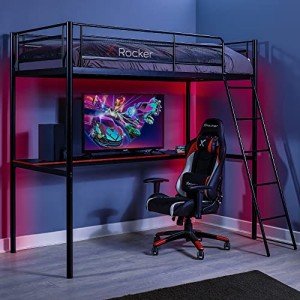Title: The Ultimate Guide to Kids Bunk Beds
Intro
As children grow, so does their need for area and storage services. Bunk beds are an excellent method to make the most of space while offering an enjoyable and practical sleeping arrangement for your kids. This extensive guide will explore the different types, advantages, safety considerations, and FAQs associated with kids bunk beds.
I. Types of Kids Bunk Beds
- Standard Bunk Beds: These are the most common type, including two twin-sized beds stacked on top of each other.
- Futon Bunk Beds: The bottom bunk is replaced with a futon, offering a couch and a bed in one piece of furniture.
- Twin-Over-Full Bunk Beds: The bottom bunk is larger, accommodating a full-sized bed mattress, while the top bunk is a twin.
- L-Shaped Bunk Beds: These consist of 2 beds placed perpendicularly, providing more floor area beneath.
- Loft Bunk Beds: A single bed is put on a raised platform, leaving space for a desk, play location, or storage beneath.
II. Advantages of Kids Bunk Beds
- Space-Saving: Bunk beds are perfect for smaller sized bed rooms, releasing up floor space for other activities and furniture.
- Enjoyable and Exciting: Children typically enjoy the novelty and adventure of climbing up to their own private sleeping area.
- Cost-Effective: Purchasing one bunk bed is more affordable than buying 2 separate beds.
- Versatile: Many bunk beds can be separated into two separate beds as children age or when area enables.
- Integrated Storage: Some bunk beds include integrated storage options, such as drawers, desks, or racks.
III. Safety Considerations
- Tough Construction: Ensure the bunk bed is made from sturdy, durable products and has a safe ladder for safe access.
- Proper Spacing: Gaps between the bed mattress and the frame need to be less than 3.5 inches to avoid entrapment.
- Appropriate Height: Select a bunk bed with an appropriate height for your child, considering their age, size, and capability to climb and down safely.
- Secure Mattresses: Use the correct size bed mattress and protect it to the bed frame to prevent it from shifting throughout sleep.
- Guardrails: Ensure guardrails are set up on both sides of the leading bunk and are at least 5 inches higher than the top of the mattress.
IV. Frequently asked questions
- What is the perfect age for a child to sleep on the leading bunk?It is typically suggested to wait till a child is at least 6 years of ages before allowing them to sleep on the leading bunk.
- Can bunk beds be separated into 2 separate beds?Yes, bunk bed deals can be disassembled and transformed into 2 separate beds.
- Just how much area is required in between the bottom of the top bunk and the top of the bottom bunk?A minimum of 2 feet 8 inches is advised for head clearance on the bottom bunk.
- Are bunk beds safe for children?When correctly put together and utilized, bunk beds are safe for children. Constantly follow security standards and ensure your child comprehends the guidelines for utilizing the bunk bed.
V. Conclusion
Kids bunk beds are a useful and enjoyable service for making the most of area and offering a distinct sleeping experience for your children. By thinking about the different types, advantages, and safety considerations, you can make a notified choice when picking the perfect bunk bed for your family.

